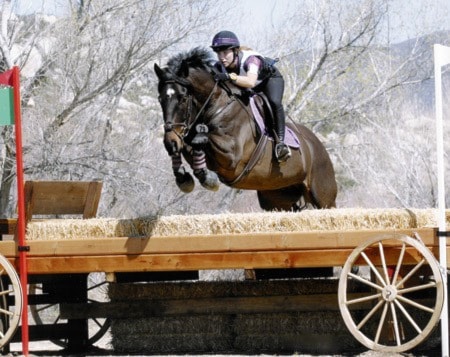Nayla Charbonneau is riding high after leading Team Canada to a first place finish at an international competition in New Zealand.
A rising talent in the sport of three-day eventing, an equestrian sport that combines dressage, cross-country and show jumping, the Cloverdale teen had to leave her trusted four-footed partner – Princeton Pride – at home.
The Inter Pacific Equestrian Exchange show jumping competition works a little differently than most; riders draw random horses, and are given only a short time to familiarize themselves with their equine partner before heading into competition.
“We just got really lucky,” Charbonneau said Monday, back home in Cloverdale where she’s about to graduate from Lord Tweedsmuir Secondary.
In show jumping, penalties are handed out for knocking down obstacles, falls, and refusals.
“It was brilliant! Everybody on our Canadian team managed to get a clear round, twice,” she says. “We were completely clear.”
Canada placed first, besting hosts New Zealand (in second place with 21 demerits), and well ahead of Australia, United States and Hong Kong.
 It’s the first time Charbonneau has competed without her horse, better known as Prince, who helped bring home a bronze medal for the Canadians at a sweltering international event in Kentucky last year.
It’s the first time Charbonneau has competed without her horse, better known as Prince, who helped bring home a bronze medal for the Canadians at a sweltering international event in Kentucky last year.
Eventing is a sport that takes horses and riders to the limit, testing endurance, technical skill, and most of all, trust.
“It’s a really great test on the riders’ skill, never mind the bond and the trust,” she says.
That bond can be a matter of life and death. At a competition last year in Montana, Charbonneau lost consciousness before completing the final jump. Somehow, Prince got them safely over the jump and headed straight over the finish line.
The level of trust between rider and horse is critical in cross country events, which involve a long, outdoor circuit containing hills, fences, water, and ditches.
“It’s a test of boldness and your bond,” Charbonneau explains. “Because if your horse doesn’t trust you, they’re not going to jump over a cliff that they can’t see the bottom of.”
In cross country – Prince’s favourite event – the obstacles are fixed, unlike show jumping, where the beams will fall away or separate if bumped.
That’s why riders wear protective gear, including steel helmets, cross country vests and blow-up vests, which are like an airbag for riders, providing a cushion should the horse fall onto the rider during a spill.
The sport of eventing is a true partnership between athletes, one equine and the other human.
“You actually have the planets lined up and you qualify for a show, where you and your horse are both sound and fit and ready to go. It’s so much work to get both of you ready at the same time.”
They train for dressage five days a week. Day six is jumping practice. “We work really hard at it,” she says.
They also head out for fitness training. They’re partial to cantering intervals on a long climb in Abbotsford, although the shoulder is narrow.
Charbonneau is at the barn three to four hours a day. She self-boards, so she has to feed Prince and do stable chores on top of training. Then she finds time for her own workouts, too, plus homework – done at midnight and during lunch.
Charbonneau ordinarily prepares for three-day riding events meticulously, memorizing jump courses and planning the smallest detail, including when she’ll touch her cap.
New Zealand was a master class in improvisation. She met her horse the day before competition; but he pulled up lame just hours before they were due to jump.
The replacement was “hot” – peppy and responsive like a hot rod, requiring a feather-light touch instead of a firm kick. She’d never ridden a horse like it. With minutes to go, the horse’s owner advised her to use a very different riding approach than she’d trained for. “Basically, if I could steer and hang on, we’d be great. This horse was like a gazelle.”
They zipped around the course at lightning speed. Nayla was surprised she didn’t fall off.
“Mentally and physically I was able to pull it together and deal with it,” she says, adding she was thrilled when the rest of her team performed so well, resulting in a first place finish for Canada.
They hadn’t supplied a CD with Canada’s national anthem for their victory entrance into the arena, so Charbonneau and her four teammates burst into O Canada instead. “We just belted at the top of our lungs. It was incredible.”
Charbonneau, whose ambitions are fixed on the 2016 Olympics, is now in the market for a thoroughbred; her trusty riding partner Prince is one-quarter Percheron draught horse, a tall, muscular breed built for pulling wagons.
His muscles help him run fast and make him an excellent jumper but his robust physique lacks the fluid lines of a warm blood (thoroughbred) for dressage, which emphasizes technique.
He also takes longer to cool down, putting him at a physical disadvantage – he might get hurt if he pushes himself too much.
But Prince won’t be going away. He was originally purchased as a trail horse for Charbonneau’s mom Tammy, and that’s what he’ll finally become.
Of course, every now and then, she’ll take him for a good gallop.
After she graduates in June, Charbonneau is taking a break from her studies. University awaits one day, but, “I need to go to the Olympics first. I can go back to school and get a career and stuff later!” She laughs. “I’m kind of on a roll.”
Follow the Cloverdale Reporter on  Twitter and
Twitter and ![]() Facebook. View our print edition online.
Facebook. View our print edition online.
